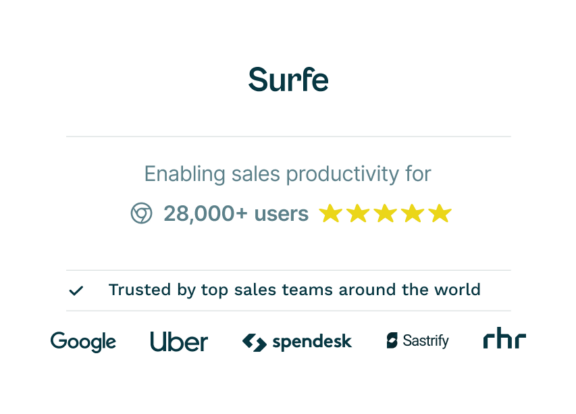Understanding Different Sales Roles: SDR, BDR, AE, and AM Explained

Things that are important, but confusing:
Taxes. The stock market. Dress codes. Keeping houseplants alive.
We’ve got one more to add to the list: Sales roles and the difference between SDRs, BDRs, AEs, and AMs. Sales teams are really, really integral to the growth of a company – we’re sure we don’t need to tell you that – but the definitions of each role can differ from business to business. The acronyms don’t help clear things up, either.
We’re going to put an end to the confusion once and for all by breaking down the unique responsibilities, goals, and value of each role in the sales team. Here’s what we’ll cover:
- What is an SDR (Sales Development Representative)?
- What is a BDR (Business Development Representative)?
- What is an AE (Account Executive)?
- What is an AM (Account Manager)?
- How These Roles Work Together in the Sales Process
By the end of this blog post, you’ll be able to define each role, what each team member does, and when they do it. This knowledge is crucial for building an efficient sales process – after all, without knowing who’s responsible for what, you won’t be able to build a system that’s efficient, scalable, and gives customers the best possible experience.
Sound good? Let’s go.
What is an SDR (Sales Development Representative)?
Let’s start at the beginning of the sales process, with the Sales Development Representative – more commonly known as an SDR.
Role and Purpose
An SDR is responsible for two things: lead generation and outreach. They find and qualify potential people to sell to. Simples.
First impressions matter – and nobody knows this better than the SDR. They’re the first point of contact with prospects, and need to impress everyone they speak to while figuring out if they’re a fit or not.
Key Responsibilities
The modern-day SDR most likely spends a lot of time on LinkedIn (lucky them – it’s our favorite social channel), as well as the company CRM and industry databases.
They’re not just stalking that person they went to nursery with, though. Instead, they’ll be conducting high volumes of outreach. The average SDR performs 94.4 activities a day, across channels including:
- Calls
- Emails
- Social media
- Voicemail
The point of all this outreach? To schedule meetings or demos with qualified leads for Account Executives (or AEs – more on them in a minute).
Why SDRs are Important
SDRs build the foundation of the sales pipeline. Their role is just as much about filtering the wrong leads out as it is bringing the right ones in – after all, the best sales teams follow a highly targeted approach rather than trying to sell to every man and his dog.
They also free up AE’s time. Early-stage prospecting and closing deals are both time-consuming tasks. Keeping them separate allows each team member to handle different stages of the sales process really, really well.
KPIs for SDRs include leads qualified, meeting set rate, and outreach activities completed.
What is a BDR (Business Development Representative)?
Next up – Business Development Representatives, or BDRs.
Role and Purpose
BDRs are similar to SDRs – and occasionally you’ll see the titles used interchangeably – but they focus on outbound prospecting, targeting new markets and partnerships rather than solely leads.
They keep an eye out for new business opportunities that align with strategic goals; larger or enterprise accounts, for example.
Key Responsibilities
BDRs have to identify and engage potential business partners or clients through outbound prospecting. This will involve a lot of market research to find new trends and potential partnership avenues.
They’ll also work closely with the rest of the sales team and marketing – it’s super important that their efforts are aligned with the rest of the company’s growth strategy.
Why BDRs are Important
BDRs are key to company growth over the next few years, as well as months. They connect with larger accounts or new markets, and their work can lead to long-term partnerships or new revenue streams.
KPIs for BDRs include number of new opportunities generated, quality of leads, and conversion to next-stage meetings or partnerships.
What is an AE (Account Executive)?
Woah, we’re flying through these! Next up – the humble Account Executive, or AE to you and me.
Role and Purpose
AE’s sit further down the funnel than SDRs and BDRs. They’re responsible for running demos and ultimately, getting prospects to sign on the bottom line.
Once they’ve received a qualified opportunity from an SDR or BDR, they work on converting them into a paying customer. That involves negotiating terms, finalizing agreements that meet customer needs, and aligning with company objectives.
Key Responsibilities
The first time a prospect meets an AE will most likely be on a product demonstration. They’ll be (hopefully) prepped and ready to answer any questions about the product or service, and to address any objections if they have to.
Once the initial conversation is out of the way, it’s down to the AE to negotiate terms, make sure everyone on the buying committee is on board, and finalize the sale with prospects.
Building good customer relationships is key here – without them, the average AE will find it difficult to close the sale and smoothly transition them over to customer support.
Why AEs are Important
AEs play a direct role in generating revenue. Without them, leads just aren’t going to turn into paying customers. They’re also best qualified to handle complex sales processes, deal negotiations, and difficult questions from prospects who want to make sure they’re making the best decision for their business.
KPIS for AEs include close rate, deal size, sales cycle length, and revenue generated.
What is an AM (Account Manager)?
The sale’s closed – yay! Who handles the next stage?
Introducing the Account Manager, or AM.
Role and Purpose
AMs are responsible for building and nurturing relationships with current clients. Getting a lead through the door is one piece of the puzzle, but it’s the aftermath that has the potential to make the biggest impact: 73% of B2B revenue comes from existing customers in the form of renewals, cross-selling, and upselling.
Unlike SDRs, BDRs, and AEs, AMs focus on the post-sale experience. If they manage to build trust and show customers why they should renew and/or update, then they’ve done their job.
Key Responsibilities
An AM is the main point of contact for clients. Everything from helping clients with queries to quarterly check-ins and resolving queries falls to them.
They need to have a close relationship with clients; the more intimately they know their accounts, the more easily they’ll be able to spot opportunities for additional products or services that could benefit their business.
Why AMs are Important
AMs build customer loyalty, and customer loyalty = increased renewal rates and more satisfied customers. If a customer feels apathetic or even negative about your business, there’s only so long they’ll stick around before going elsewhere.
Key metrics for AMs include customer retention rate, expansion revenue, Net Promoter Score (NPS), and renewal rate.
How These Roles Work Together in the Sales Process
Now it’s time to put it all together. How do the above roles create a sales process that’s efficient, easy, and enjoyable for both the team and the customer?
The handoff process: SDRs and BDRs work their magic identifying and qualifying leads. They then pass them to AEs to close. Once closed, AEs transfer the account to AMs for ongoing relationship management. Simple.
Collaboration and Communication: clear communication between each role is vital. Transitions should feel totally seamless (for the customer, at the very least).
Impact on Overall Sales Strategy: a sales team should be greater than the sum of its parts. In other words, each individual should do a good job alone, but a great one together. Without everyone working in synchrony, it’s unlikely that the sales funnel will be efficient and the business will experience maximum value.
Let’s Wrap It Up!
You can cross ‘understanding different sales roles’ off the confusing list!
By now, you should have a good understanding of what each role does, be able to decipher those pesky acronyms, and see how they all fit into the effective-sales-machine puzzle. Feels pretty good, right?
Next up, understanding taxes. Anyone care to enlighten us?

Hey – we forgot something!
One tool that’s crucial for sales teams is Surfe. It’s going to save you a lot of blood, sweat, and years – whatever your role is. Try it for free today.
FAQs About Understanding Sales Roles
What Are The Main Sales Roles In A Business?
Sales teams typically have four key roles: Sales Development Representatives (SDRs), Business Development Representatives (BDRs), Account Executives (AEs), and Account Managers (AMs). Each role has its own responsibilities that contribute to the sales pipeline:
- SDRs focus on lead generation and outreach and qualifying potential leads.
- BDRs take a broader approach, identifying new business opportunities and partnerships.
- AEs work to convert prospects into paying customers.
- AMs focus on nurturing existing client relationships and keeping customers satisfied, with the ultimate goal of renewing, cross-selling, or upselling.
Understanding these roles can help businesses build an efficient and effective sales team.
How Do SDRs And BDRs Differ In Sales?
Although SDRs and BDRs are sometimes used interchangeably, they serve distinct purposes. SDRs primarily focus on inbound lead qualification and early engagement, reaching out to potential clients who may already have an interest in the product. BDRs, on the other hand, are more proactive. They target new markets and partnerships through outbound outreach, and research trends, identify larger accounts, and collaborate with other departments to align sales efforts with business goals. Together, SDRs and BDRs build a pipeline that helps drive the company’s growth by connecting with the right opportunities.
What Does An Account Executive (AE) Do In Sales?
Account Executives, or AEs, are responsible for converting qualified leads into customers. They’re further along in the sales funnel, handling demos, negotiations, and finalizing deals. After receiving a qualified lead from an SDR or BDR, AEs introduce the product, address any questions, and work to gain commitment from the customer. They’re crucial in revenue generation, making sure each sale meets both the client’s and company’s needs. AEs are skilled in building rapport and tackling complex sales processes, which ultimately helps close deals and contributes to the company’s revenue.
What Is The Role Of An Account Manager (AM) In Sales?
An Account Manager, or AM, maintains relationships with clients after a sale is closed. Their job is to make sure customers stay happy, supported, and engaged with the product or service. AMs handle everything from answering customer queries to identifying upsell opportunities, ultimately increasing the company’s retention rate. Unlike SDRs, BDRs, and AEs, who focus on new sales, AMs are dedicated to the customer’s long-term satisfaction and loyalty. With strong client relationships, AMs drive renewals, cross-sales, and upsells, helping increase the business’s revenue from existing customers.
How Do Different Sales Roles Work Together In The Sales Process?
Each sales role contributes to a seamless customer journey. SDRs and BDRs kick off the process by identifying and qualifying leads. These leads are then handed over to AEs, who work to close deals with prospects. Once a sale is completed, AMs take over, focusing on ongoing customer support and relationship-building. Clear communication between each role is essential to ensure smooth handoffs and an efficient sales process. When each role works in harmony, the result is a cohesive sales experience that’s beneficial for both the company and the customer.


